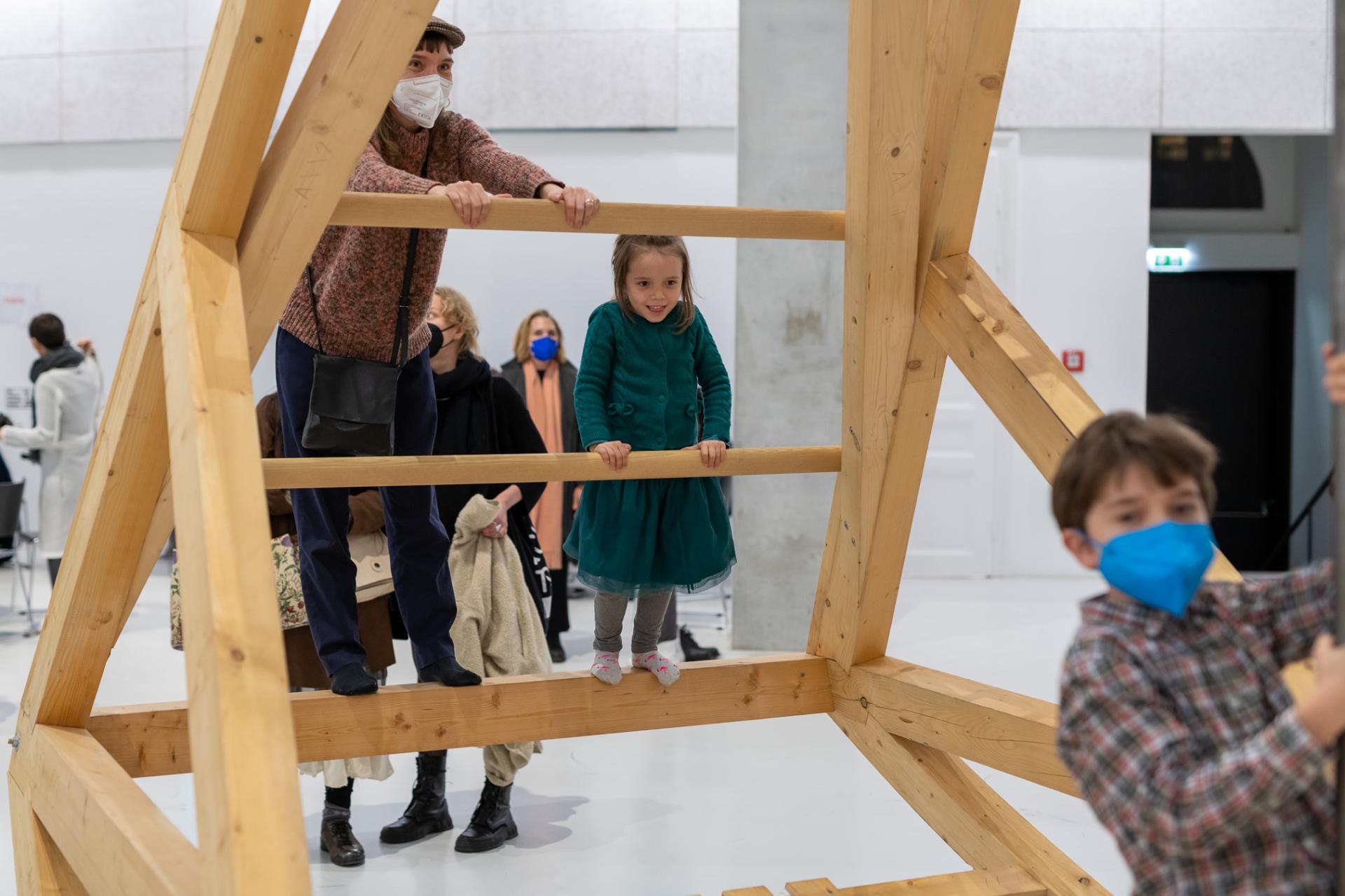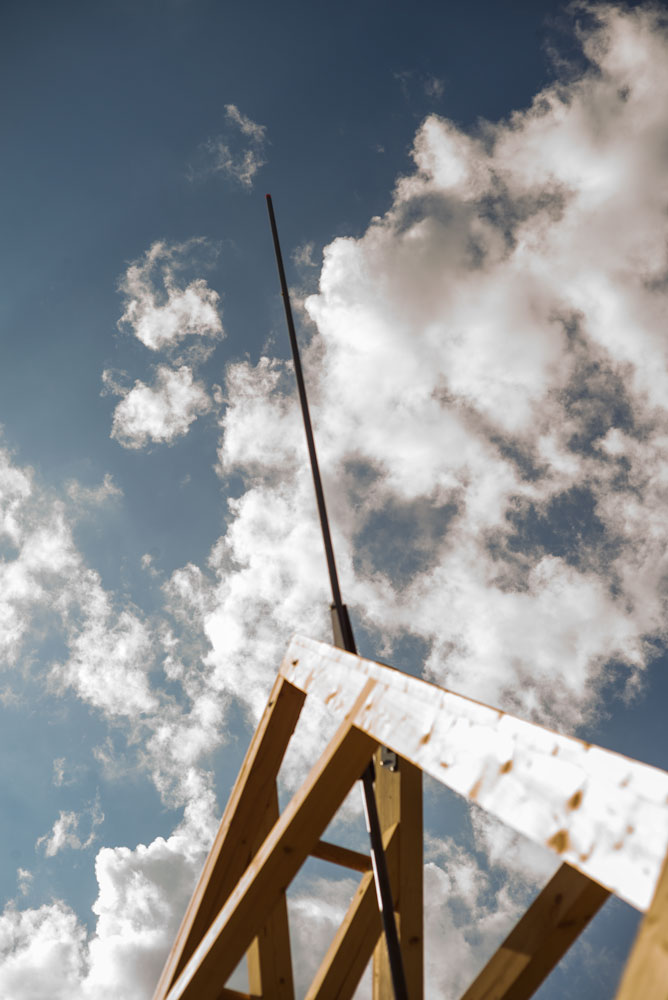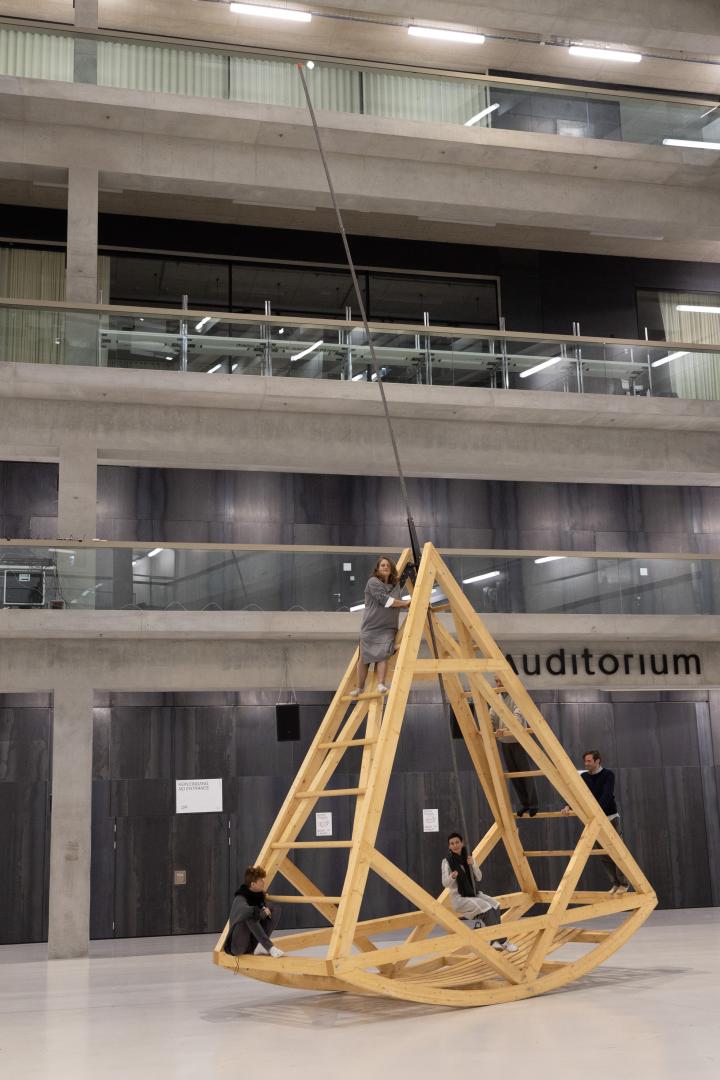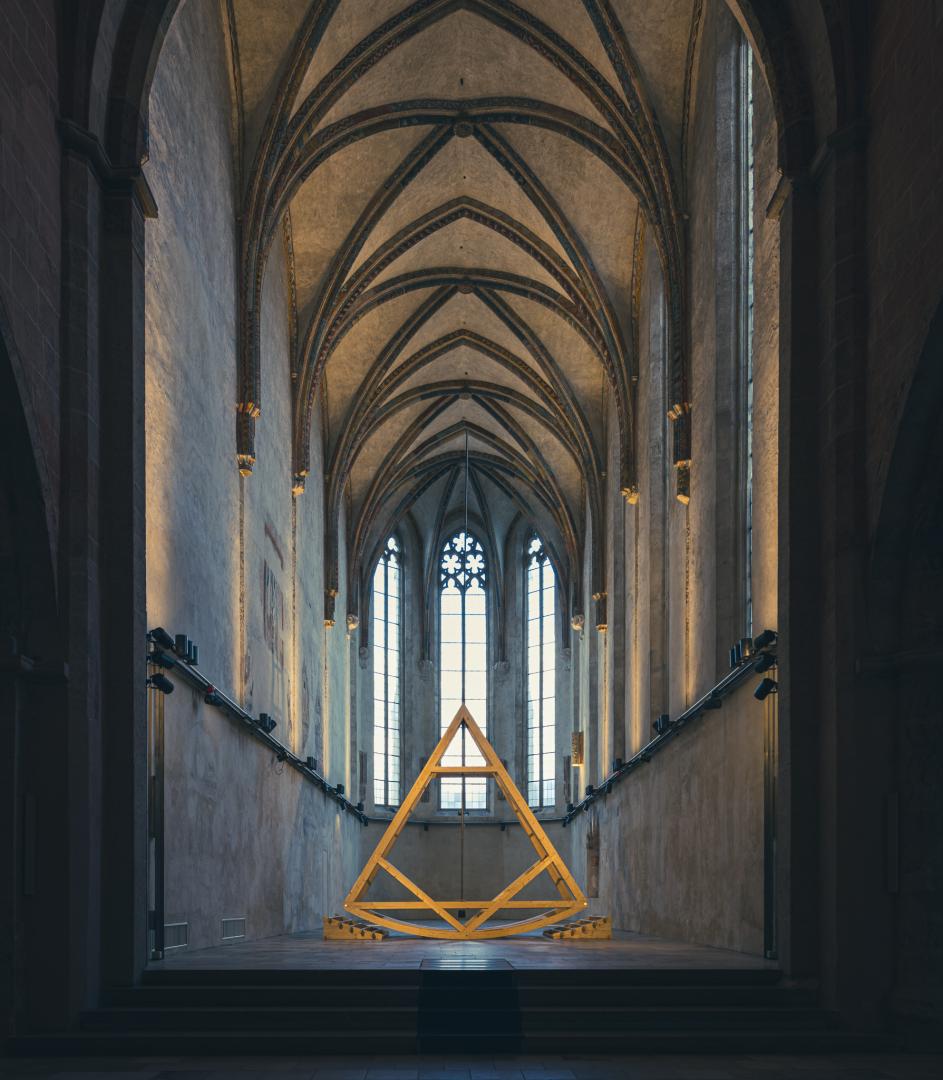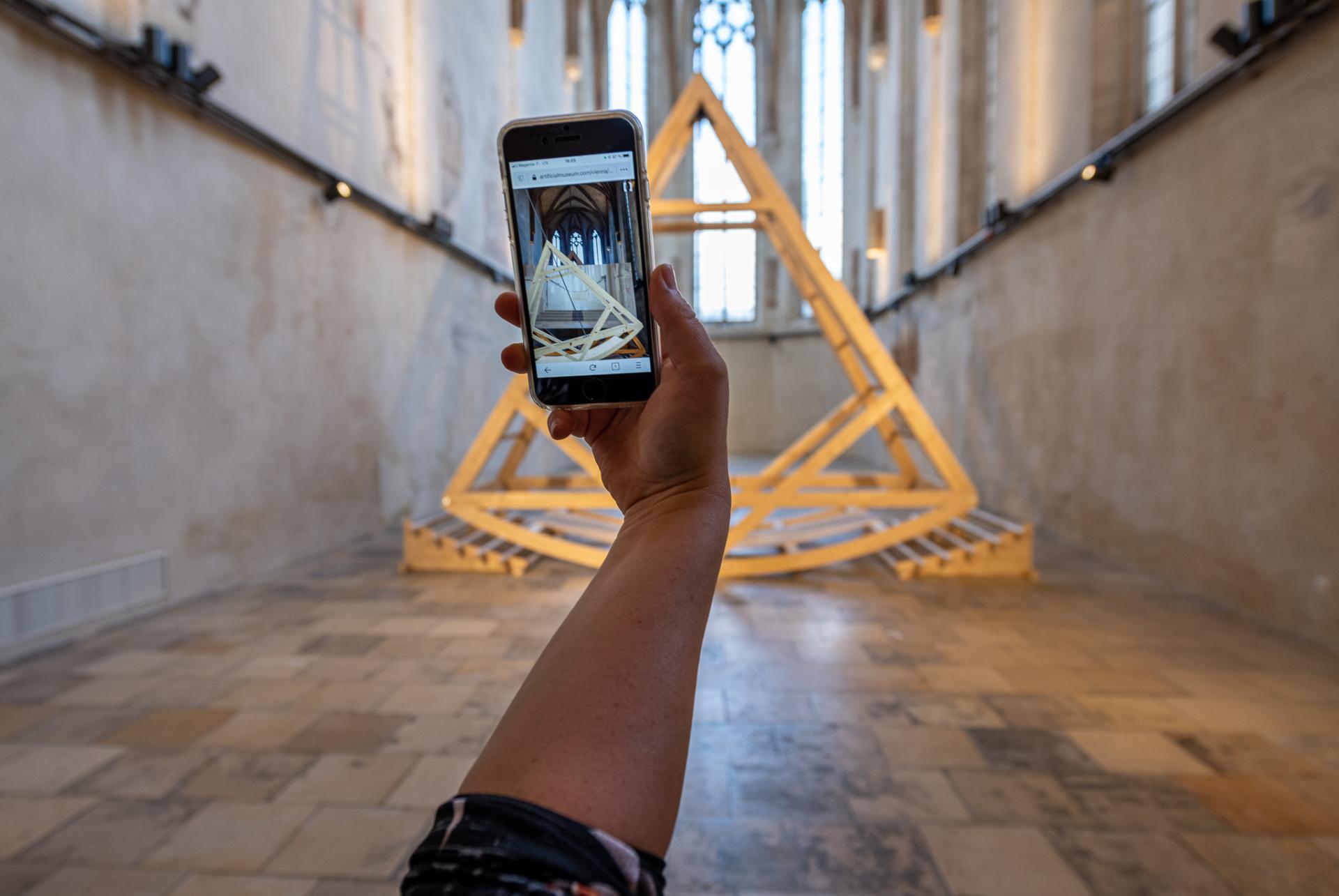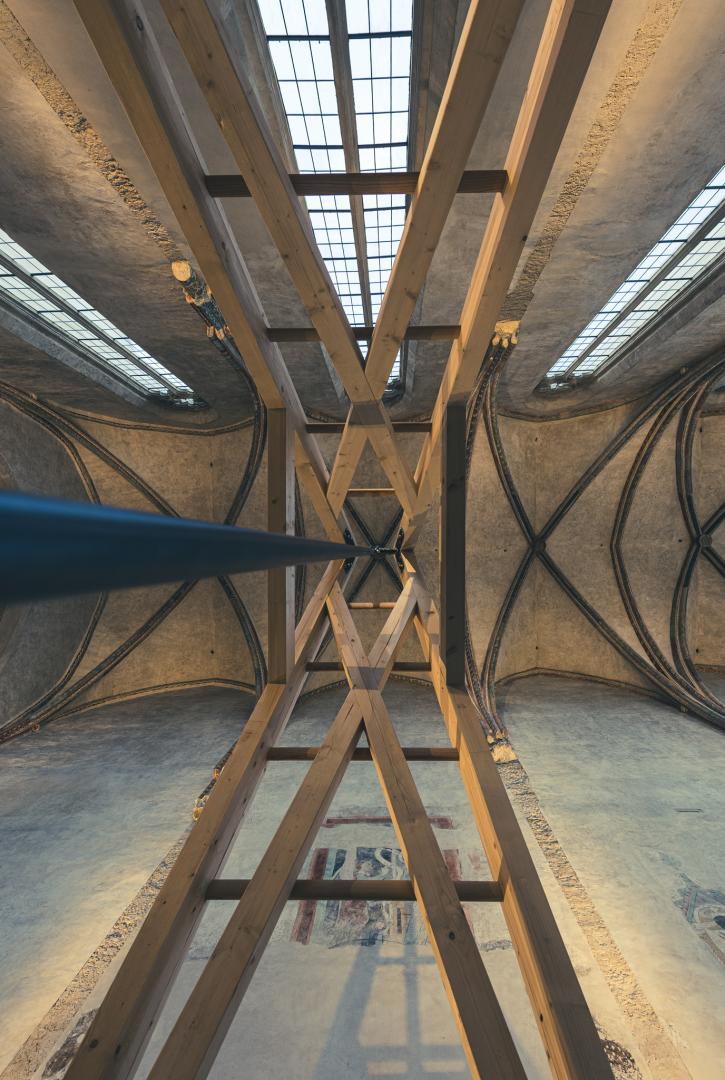A
Basic information
Project Title
Full project title
Category
Project Description
"A - A Three Body Problem" by Barbis Ruder moves at the interface of visual art, performance, music, physics and cross-disciplinary social challenges. A huge wooden kinetic sculpture in the form of the letter "A", which does not unfold its full potential without interaction, and two musical video works dealing with the concert pitch "A" questioning the interplay and harmony of bodies in relation to space.
Geographical Scope
Project Region
Urban or rural issues
Physical or other transformations
EU Programme or fund
Which funds
Description of the project
Summary
A system of bodies needs to agree on a certain norm and order to function. Especially when sharing a limited space societal and cultural codes of behaviour play an important role. But norms can also be repressive and often leave many out. Still, agreeing on particular norms can also open up spaces and enable encounters.
Inspired by the Gothic architecture of the Dominikanerkirche in Krems (Austria), artist Barbis Ruder's three-part work titled “A” negotiates the relationship of body to sculptural body (corpus) and its relation to architectural space. Referencing the idea of finding a common ground or unit, the artwork “A” is a three-part work that is made up of a performative instrument, inscription and sound. It spans a triangle for body, mind and soul, which can oscillate in a slightly uncontrollable manner.
A - Inscription: A video loop of the inscription of the body into architecture, the body moves along the edges of the space in time to a vibrating A-string.
A - Choir: “A” locates the note of the concert pitch “A”, and is performed by a choir, live performance and video work.
A - Instrument: The instrument “A” is a kinetic sculpture, consisting of a triangle, based on a roof truss and the technical skills and knowledge of traditional architecture, carpentry and engineering. The bottom is rounded into a seesaw, a long pendulum holds the triangle at the top and reaches far into the sky. It is an instrument for the trinity of body, mind and spirit that requires at least three people to play. One person sits at the base of the pendulum while the other two stand or climb on the edges. Together they set the tempo. They make the composition swing with and against each other, like a slowly swinging metronome. There are moments of tension between equilibrium and possible tipping moments of the construction.
The oscillation of the instrument can also be viewed via augmented reality using a smartphone: https://artificialmuseum.com
Key objectives for sustainability
"A" is a good example of art and sustainability coming together. More and more artists are questioning and/or addressing the significance of art in the area of sustainability in their works or in their implementation. Artists become changemakers and they look for a certain balance in their work.
Sustainability plays several roles in Barbis Ruder's work and takes place on the level of the material, on the level of the theoretical examination of the construction as well as on the level of experience of the audience or the players.
Barbis Ruder’s artistic practice focuses on a responsible use of resources, even if - as in the case of "A" - it is a very large-scale work. "A" is not only built from a sustainable material, wood, the sculpture was also achieved with maximum respect for resources. When possible, for example in relation to the metal pendulum’s counter-weight, material was also recycled. "A" can be dismantled and reassembled at any time, is easy to transport and can thus be shown again and again in different places and thus enables experiences to a wide audience.
In the construction of the work she deals with old techniques. Thus, the "old" knowledge or tradition of handcraft (carpentry) is also reused and it experiences a continuation in her artistic work: The roof truss of the Dominikanerkirche Krems was the main inspiration for the project. Based on classic skills from carpentry, and the knowledge and materiality from local handicraft a new hybrid form is created.
And - last but not least - it can be experienced without travelling. Artist Litto (Daniela Weiss) created the “A”’s virtual reality and gave it a forever online home within the “Artificial Museum”.
Key objectives for aesthetics and quality
“A” is not only a three-series work and can be experienced by the trinity of body, mind and soul, the harmony is visibly inscribed in the artwork through harmonious and aesthetic relationships and can be heard through the video installation which deals with bodies (choir) and the chamber tone “A”. Additionally it can also be experienced via augmented reality (“Artificial Museum”).
The kinetic sculpture, which at first sight probably seems overpowering, invites you to enter and play on it and can thus easily transfer the inscribed harmony of aesthetics - of its movement or of its ratios - to the audience. “A” is both stable and movable: A body for many bodies, a place where many citizens can meet, play, swing, and probably create sound together. The oscillation of two sine waves is only feelable when one gets involved in a gentle way. Force can not be used to move the sculpture. It is important to feel the instrument, feel and be in touch with the others, be aware of the space and the situation, and - as a union of bodies - the togetherness of the unpredictable rocking, a playfield for adults (and non-adults) is opened up. People experiencing the object can test their own boundaries in a swinging balance and how a small impulse can have a large effect on the pendulum. You have to be careful with the object and take responsibility for your own impulse that you set. "A" stands for a perfect interaction and for the impact one has on a system as an individual. You can experience your own humbleness towards systems while becoming more and more calm and balanced.
"A" thematizes a state that is easier to experience than to put into words. The experience nearly replaces an intellectual debate. "A" is not a work of art on a high pedestal that must not be touched, "A" is an including experience of a community.
Key objectives for inclusion
As a female artist, Barbis Ruder follows a tradition of numerous female artists who only gained attention through the use of their bodies. The body, in its bareness, in its mass and with its forms (described as explicitly female), represented a special moment in art history for a long time. But Barbis Ruder always goes further in her works, focuses on togetherness, on cooperation in a team and puts different actors, who can be performers as well as the components of space, time and light, into a relationship.
The A as a photographic inscription of the body in space, is a multi-layered exposure within the architecture of Dominikanerkirche in Krems. It takes 20 bodies - or 20 photographs to cover the edge and capture the space in relation to the body. In the final result it remains as an organic irritation.
There is a moment in contemporary art that has propelled works on high pedestals or behind glass. Art has been denied a comprehensive character of experience and reduced to experience through seeing. “A” consciously opposes this and wants to help the body, mind and soul to experience in equal measure.
Public participation is decisive in the case of “A”. Without an audience, the kinetic sculpture remains in silence and immobility and cannot show its spectrum. Only a very conscious engagement with the work completes the idea. The concert pitch "A", which is central to the video work, represents just as much a unifying and inclusive moment as the movement of the sculpture by at least three people. Only when all of them (musicians or players of the sculpture) have joined in does a harmonic unison emerge. Barbis Ruder, however, adds another component to her work: through the online-realisation in the “Artificial Museum”, she makes her work accessible to a wide audience, no matter where they are. In the digital realisation, the A sounds and the kinetic sculpture vibrates without a cast, even the Gothic choir of the Dominikanerkirche in Krems can be seen.
Results in relation to category
Regaining a sense of belonging: What happens here on a small scale can easily be scaled to much larger systems. Every action, no matter how small, is followed by a reaction. Translated to the level of movement, this can easily be felt and experienced, just as this process can be heard in music - the choir trying to find the concert pitch together in order to tune into the consonance of a melody. Physical movement and sound, which both generally means nothing other than vibration, play an important role both in the manifestation and in the audible realisation.
Regaining a sense of belonging: In "A", the human being is not decisive in his transhuman improvement, but as a physical object with his biological stages of development and his ability to reflect on action and reaction. "A" reflects a respectful togetherness and aims at a physical experience. The human being is not confronted with cyborg-like themes or attacks, but with the moment of pure being and feeling.
Regaining a sense of belonging: Physical experience was hardly possible due to the spread of Covid-19. The previous exhibitions of "A" were determined by the pandemic and lockdowns imposed in Austria. But it was precisely in these times that Barbis Ruder was able to unlock a kind of "healing" – the gentle vibrations and soothing rocking movements of the “instrument” or the sculpture, the sounding of the chamber tone, the communal experience etc. set a counterpoint to the hectic and sorrowful world. Barbis also could renew her sense of belonging as an artist. Undoubtedly, access to the exhibition was reserved for only a few due to the prevailing regulations. The artist is looking forward to hopefully making "A" accessible to a wide audience soon.
How Citizens benefit
A starting point of Barbis Ruder's work was the moment of being together and experiencing. She did not only work with a team in the planning - among others, the architect and carpenter Philipp Reinsberg developed the construction of the kinetic sculpture or the artist Litto (Daniela Weiss) translated the work into the virtual world - the complete work is designed for an interplay, for teamwork. It takes away the inhibitions of the audience, who mostly only look at the work, and are not allowed to experience art with other senses as well. One can touch everything here, use it, play with it or just observe and analyse the interaction of the others. The audience is free to become players or "only" spectators.
Barbis Ruder's art is not only usable, it is also meant to make the world a better place - through accessibility, by opening up the much-cited fourth wall and through interaction.
Barbis Ruder will continue to work with local choirs to provide a live moment in addition to the video work.
Opinions from the audience so far: “One could see how the subtle movements appealed to the guest, as they were appreciating the rhythmic minor movements and how these movements affected the body. Some guests who took this approach closed their eyes, layed down on the sculpture, or even fell asleep.” / “In the reception I asked myself the question, who is the object and who is the performer. How are these boundaries renegotiated through this imposing object? (…) In my opinion, the concept of the instrument is exciting in that the artist assigns a new musical-poetic dimension to this material confrontation, drawing attention to the complexification of nature-culture relationships as a continuum and balance as well as mutual trust and their dependence in a new-material sense.” / “I loved this artwork, because it’s so physically interactive. I often miss this in the cold white cubes. (...) I sometimes ask myself: when did art become so dead? But this artwork was alive.
Physical or other transformations
Innovative character
Art for Change. At the centre of Barbis Ruder's artistic practice is not her own vanity, an artistic will and ability or an innovation celebrated on the art market, but the impact that an artistic work can have. In her projects, which can be classified as Artistic Research, she also deals with marginal issues, which for many, however, mean a whole world. Through the aesthetics which are often immanent in art, art is able to bring topics to the surface that are overseen elsewhere. Making the world vibrate, weaving sound and movement into a powerful installation that invites the viewer to experience it, is the focus of her artistic exploration.
Normally, the audience is kept on the outside. Not so with Barbis Ruder. The human body has always played a role, with "A" she also allows the audience with its different bodies to experience a situation normally reserved for professional performers.
Collective work in contemporary art, the use of transmedial techniques and the interdisciplinary interaction of collaborators are the focus of Barbis Ruder's work "A". This anticipates the effect of the artwork already in its development, which is certainly noticeable in the final experience, which is strongly based on participation.
Learning transferred to other parties
Barbis Ruder's approach can be effortlessly transferred to other disciplines, as she demonstrates with her team at “Phantom Lab”, for example. “Phantom Lab” is a joint research group led by performance artist Barbis Ruder, philosopher and cultural theorist Lona Gaikis and industrial designer Walter Lunzer. Currently based at the Angewandte Performance Lab (APL) in Vienna, their work engages the needs of upper limb prosthesis wearers to integrate their notion of ‘feeling’ as a novel paradigm to clinical study and medical engineering. The group models workshop settings that raise attention to marginalised bodies in medical design processes. “Phantom Lab” opens dialogues with prosthesis wearers in the development of medical devices on eye-level, as it flips the sides of the clinical gaze to find out what can be learned from bodies that are generally labelled as ‘pathological’. In its approach, this collaboration also relies on basic principles of living together. Skills from the most diverse fields are brought in, experiences are shared and discussed in the group, results benefit those who can profit from them first and foremost and directly.
One could also say that Barbis Ruder has a dialogue inscribed in her way of working. If at the beginning the focus was perhaps on her own very human body and its possibilities and impossibilities, with “A” she not only opens up the boundary of her own being towards a new humanity, but also wants to share her own experience, which she was allowed to collect in her performances, with the audience as they are taking part in the whole process of “A”. With an audience on site, in front of the screens and basically with the whole world. Very specifically, she makes her artistic skills available to a global change and participation.
The work will also be shown in Germany in the foreseeable future and is accompanied by a wide range of educational activities, from physics to visual arts and music to crafts.

